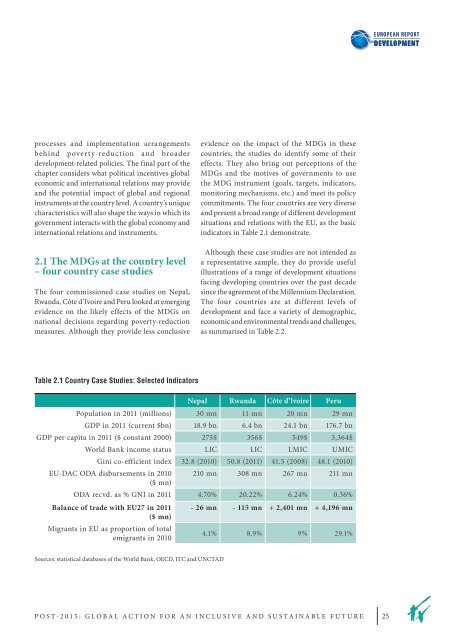Post 2015: Global Action for an Inclusive and Sustainable Future
Post 2015: Global Action for an Inclusive and Sustainable Future
Post 2015: Global Action for an Inclusive and Sustainable Future
You also want an ePaper? Increase the reach of your titles
YUMPU automatically turns print PDFs into web optimized ePapers that Google loves.
processes <strong>an</strong>d implementation arr<strong>an</strong>gements<br />
behind poverty-reduction <strong>an</strong>d broader<br />
development-related policies. the final part of the<br />
chapter considers what political incentives global<br />
economic <strong>an</strong>d international relations may provide<br />
<strong>an</strong>d the potential impact of global <strong>an</strong>d regional<br />
instruments at the country level. a country’s unique<br />
characteristics will also shape the ways in which its<br />
government interacts with the global economy <strong>an</strong>d<br />
international relations <strong>an</strong>d instruments.<br />
2.1 The MDGs at the country level<br />
– four country case studies<br />
the four commissioned case studies on nepal,<br />
rw<strong>an</strong>da, côte d’Ivoire <strong>an</strong>d peru looked at emerging<br />
evidence on the likely effects of the mDGs on<br />
national decisions regarding poverty-reduction<br />
measures. although they provide less conclusive<br />
Table 2.1 Country Case Studies: Selected Indicators<br />
evidence on the impact of the mDGs in these<br />
countries, the studies do identify some of their<br />
effects. they also bring out perceptions of the<br />
mDGs <strong>an</strong>d the motives of governments to use<br />
the mDG instrument (goals, targets, indicators,<br />
monitoring mech<strong>an</strong>isms, etc.) <strong>an</strong>d meet its policy<br />
commitments. the four countries are very diverse<br />
<strong>an</strong>d present a broad r<strong>an</strong>ge of different development<br />
situations <strong>an</strong>d relations with the Eu, as the basic<br />
indicators in table 2.1 demonstrate.<br />
although these case studies are not intended as<br />
a representative sample, they do provide useful<br />
illustrations of a r<strong>an</strong>ge of development situations<br />
facing developing countries over the past decade<br />
since the agreement of the millennium Declaration.<br />
the four countries are at different levels of<br />
development <strong>an</strong>d face a variety of demographic,<br />
economic <strong>an</strong>d environmental trends <strong>an</strong>d challenges,<br />
as summarised in table 2.2.<br />
Nepal Rw<strong>an</strong>da Côte d’Ivoire Peru<br />
population in 2011 (millions) 30 mn 11 mn 20 mn 29 mn<br />
GDp in 2011 (current $bn) 18.9 bn 6.4 bn 24.1 bn 176.7 bn<br />
GDp per capita in 2011 ($ const<strong>an</strong>t 2000) 275$ 356$ 549$ 3,364$<br />
World b<strong>an</strong>k income status lIc lIc lmIc umIc<br />
Gini co-efficient index 32.8 (2010) 50.8 (2011) 41.5 (2008) 48.1 (2010)<br />
Eu-Dac oDa disbursements in 2010<br />
($ mn)<br />
210 mn 308 mn 267 mn 211 mn<br />
oDa recvd. as % GnI in 2011 4.70% 20.22% 6.24% 0.36%<br />
Bal<strong>an</strong>ce of trade with EU27 in 2011<br />
($ mn)<br />
migr<strong>an</strong>ts in Eu as proportion of total<br />
emigr<strong>an</strong>ts in 2010<br />
Sources: statistical databases of the World b<strong>an</strong>k, oEcD, Itc <strong>an</strong>d unctaD<br />
- 26 mn - 115 mn + 2,401 mn + 4,196 mn<br />
4.1% 8.9% 9% 29.1%<br />
poSt-<strong>2015</strong>: <strong>Global</strong> actIon For <strong>an</strong> IncluSIvE <strong>an</strong>D SuStaInablE FuturE<br />
25

















